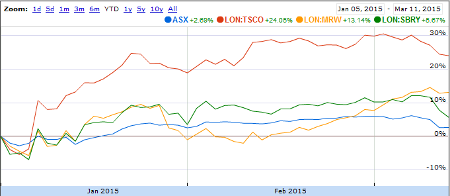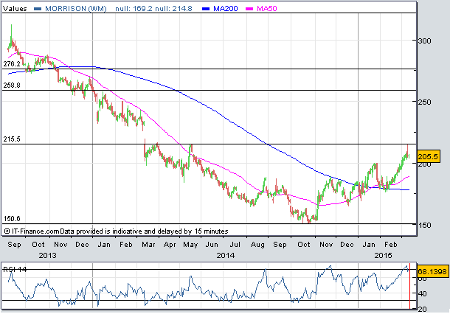Big Three supermarkets' prospects examined
11th March 2015 12:21
by Harriet Mann from interactive investor
Share on
The UK economic recovery has buoyed many industries, but it looks to be side-stepping the retail sector, experts have warned. True, sentiment toward the sector has improved this year, but the "Big Three" listed supermarkets massively underperformed the FTSE All Share index in 2014, and these latest warning suggest the industry recovery is already at risk.
Retail sales did inch up by 0.2% on a like-for-like basis in February, and total food sales grew for the third consecutive month, the best performance since January last year. Once again, increases in the sale of non-food products online stood out, although this slowed from 14.3% to 8.3% year-on-year. That this all happened in a typically quiet month is a good sign. However, the figures were unimpressive, which implies the economic recovery sweeping benefiting other industries is "bypassing the retail sector". That's particularly surprising given low interest rates, said accountancy firm KPMG’s head of retail David McCorquodale.
"Activity on the high street has settled into a monotonous equilibrium, with falling like-for-like food sales persistently wiping out any meaningful like-for-like growth the non-food sector manages to achieve," he says. "February's figures are also against very weak comparables, when bad weather caused sales to stall last year."
Instead, he thinks the extra money consumers have is going into restaurant's pockets, ignoring the cheap food on supermarket shelves. The price war battle between the major food retailers and their discount rivals has driven grocery deflation to a new low of -1.6% for the 12 weeks to 1 March, saving shoppers a whopping £400 million, new data from Katar Worldpanel shows.

Comparable performance in 2014. Source: Google
Joanne Denney-Finch, chief executive of retail goods charity IGD says: "With energy and ingredient cost reductions continuing to work their way through the supply chain, food retailers have been buying and selling at lower prices.
"So although February's food and drink sales figures were almost identical to last year's, it means shoppers are investing their savings back into better quality groceries - helping to boost volumes. Our ShopperVista research shows 31% of shoppers now say product quality is extremely important when deciding where to buy their groceries, compared to 27% who said the same last year."

Comparable performance in 2015 so far. Source: Google
Deutsche Bank reckons the bigger supermarkets' investment in price and service should stem market share loss in 2015, especially with Aldi's capacity constraints. While market underperformance fell from a 120 basis points (bps) deficit to 140bps, this is materially improved from the 250bps underperformance reported in 2014. Forecasting an increase in market growth from 0.7% for the first two months of the year to 1.5% for the full year, the retailers are relying on this momentum to help them achieve forecasts.
Conditions remain tough. Just how tough will be spelled out in full-year results due out in the coming weeks. Competition remains fierce, but increased disposable income, slower growth among the discounters and the return of food inflation means risk is increasingly to the upside.
Tesco
While all three of the big supermarkets suffered in 2014, bore the brunt of investor anger following a series of profits warnings and accountancy scandal which resulted in an entirely new management team - new chief executive Dave Lewis took the helm on 1 September. But many in the City think the rout is over, and the share price has outperformed the FTSE All Share by over 20% in the year-to-date.
Investors will have to wait longest for Tesco's results, scheduled for 22 April, but data from Kantar suggests it has been the standout retailer in the 12 weeks to 1 March with sales up 1.1%, its strongest performance in 18 months. Market share is down just 0.1 percentage points compared to last year. This comes after better-than-expected trading over Christmas and positive reaction to Lewis’s recovery plan.
"A quick improvement in sales has shown the market that Tesco's recent share losses are not necessarily inevitable - and the rebasing of margins to c1% means that the next move is likely to be up rather than down," says Barclays.
Its team of analysts call the grocer's recovery plan "eminently sensible," but warn that the current share price assumes a relatively quick recovery or some accretive disposals, "neither of which can be taken for granted".
From sales of £62.3 billion in the year to February, net income is set to total £767 million, generating earnings per share (EPS) of 9p. At 240p, this puts Tesco on a price/earnings multiple of 25.7 times, expensive compared to its peers. Its free cash flow (FCF) yield of 7% is largely attributed to its restrained capital spend, according to Barclays, which has been lowered to £1 billion for the year ahead.
"FCF yields will likely not remain at high single digit levels - FCF estimates will fall or share prices will rise. This rationale has helped explain the share price rise of Delhaize and the strong YTD performance of Tesco. From where we stand today, there are two particular stocks in this category - Sainsbury's and Morrisons. We tend to think that the FCF yield is more likely to normalise through falling FCF estimates rather than through rising share prices, especially at the latter."
With like-for-like sales growth only scheduled for 2017, Tesco clearly still has a lot of work to do and much is already priced in. Barclays has an 'equal-weight' rating on the stock with a 205p target price.
Morrisons
The first of the big three to report will be on 12 March. It fared best in 2014 in terms of share price performance, and has just been upgraded from 'underweight' to 'neutral' by broker JP Morgan. Although Kantar notes Morrisons' sales were behind the market average, falling by 0.4% in the 12 weeks to 1 March, JP Morgan reckons its new management team - industry veteran David Potts takes over from Dalton Philips next week - greater cost cutting opportunities and stronger balance sheet should position it well in the coming months, especially as it now trades on a less demanding valuation.
Upgrading its 2014/2015 pre-tax profit guidance by 11% to £422 million, the broker reckons sales excluding petrol will be down 2.5%, much better than the average 7% fall seen in the first nine months of the year. This implies a fall of just 1.9% in the last seven weeks of the final quarter. Asset disposals and should help lower net debt to £2.2 billion, £200 million under company guidance.

Although Barclays puts Morrisons' free cash flow yield at 9%, the general consensus is that its 2015/2016 dividends are going to be cut. JP Morgan reckons it could even be halved. The shares currently trade on 16 times forward earnings.
Sainsbury's
has managed to keep its sales and profits rather safe during recent turbulence, especially compared to its listed peers. Luckily for investors, Barclays reckons this resilience could be sustainable given its "differentiated offering, consistent execution and the format/geographical advantages of its store network". But the City isn't totally convinced and when pitted again Tesco and its predicted growth against easier comparative periods, a re-rating in the near future looks unlikely, Barclays adds.
"Near-term trading outlook may be more challenging for Sainsbury's than peers: All three of the UK-listed food retailers face relatively easier comps in 1H15, but this is truer of Morrisons and Tesco than it is of Sainsbury. While the market will likely see through 'weak comps' to some extent, we would expect to see Sainsbury's outperformance diminish somewhat. Given this was in recent times one of the key bull points for Sainsbury, it is a concern if its relative sales strength seems to dissipate."
Barclays reckons net income of £470 million will be generated from its £23.7 billion turnover in 2014, with its EPS closing the year at 25p.
"Sainsbury is trading on a 2016E PE of c12.1x – this is certainly a significant discount to the wider sector at c16.9x, but the stock has traded at significantly lower multiples in the recent past."
This article is for information and discussion purposes only and does not form a recommendation to invest or otherwise. The value of an investment may fall. The investments referred to in this article may not be suitable for all investors, and if in doubt, an investor should seek advice from a qualified investment adviser.